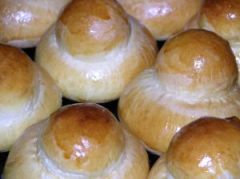In case you missed it, Canada Day was a few weekends ago! Canada Day is A Big Deal here in Ottawa, something I wasn’t really prepared for until I moved here five years ago. People in the National Capital Region take Canada Day very seriously; even the people who would never venture onto the Hill for the celebrations hold their own parties, in backyards and parks across the city. If viewed from space on July 1, I’m convinced you would be able to pick out Ottawa by its sea of red and white: clothing, flags, banners, leis, and, bien sûr, food.
This year, we received our first Canada Day garden party invitation. The theme of this party was red and white, and I was tasked with bringing a red-and-white dessert. Excited as we were, we were (well, I was) also a little nervous, as this was a party involving some people whose opinions really matter to me, and who I hold in high esteem. I was also one of the younger people invited; I actually feel more comfortable around older people than people my own age (a weird consequence of a colourful childhood) but I was still a little self-conscious.
Add to that the fact that I am not really a dessert person, and you have a recipe for some anxiety. Don’t get me wrong: if someone set a warm chocolate cake in front of me, I would eat a piece (probably), but I’m just not emotional about dessert in the way that I am about, say, cheese. I have been known to throw a dinner party and forget to arrange for dessert.
As a result, I don’t have many dessert recipes in my repertoire. After ruling out some kind of cookie (boring and … time-consuming?) and a pie (pastry? I didn’t think this was the occasion to try to make something that I’ve never made before…) I was beginning to get a bit panicky. In fact, truth be told, my internal monologue was beginning to remind me of one of my favourite children’s book characters, the dog Tootle. Nervous about his mistress’s upcoming party, Tootle tries to learn to walk on two legs, to no avail.
After a bath (ok, a shower) and a good brushing, I came to my senses and checked out some recipes online. I came up with this gem from the Chatelaine website: strawberry shortcake tiramisu. If there’s one dessert I can always get behind, it’s tiramisu (let’s be honest: it’s the cheese)!
Never have strawberries been hucked and sliced with such care. Never has such expensive chocolate sauce been called into duty in my household. I had to make some adjustments to ensure this easy (no baking!) recipe would work in a party setting at someone else’s home.
Concluding it would be tiresome to have to melt and pour out the chocolate sauce, I decided to whip it with some of the extra whipped cream and smooth it onto the top layer. This left the top (well, bottom, when you’re making it) exposed: eek! Unsightly ladyfingers! To distract my esteemed party-goers, I layered some strawberry slivers along the top in two rows (like train tracks; I suppose, in retrospect, I could have been more creative with this design. A maple leaf would be a nice goal to aspire to, I would imagine).
I am thrilled to report the flipping of the dish was accomplished (by me, after a glass of wine) with what could almost be called actual panache; coming from a girl who once “helped” drop a $90 cake for a library summer reading club party, this was no small feat. My strawberry shortcake tiramisu received some lovely “ooohs” and “aaahs”, and the entire thing was gobbled up in no time! My first “real” dessert was a success!
I was far too nervous, and my head was much too full of various things to remember, to take pictures of this fledgeling foray into sweet things. I did, however, have a running monologue to you, dear readers, in my head while preparing this dish. I also had some leftover mascarpone cheese that was calling out to me to be made into strawberry shortcake tiramisu 2.0. My best friend’s recent visit to Ottawa provided the perfect opportunity to make this dish again, document it properly for all of you, and perhaps even enjoy it more the second time around.
For reference, the local Italian grocery recommended Igor mascarpone as the best, and I splurged for Stonewall Kitchen Mocha Espresso sauce, which was divine (a few spoonfuls disappeared somehow along the way…).
Do you think I’m ready for pastry? Or maybe I should start with a crumble crust. That seems like a safe gateway drug before harder stuff. I do like a good Key Lime Pie….
















